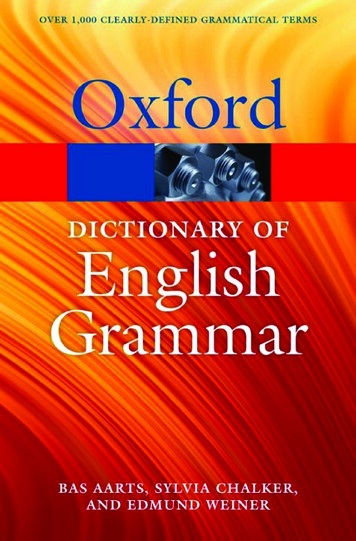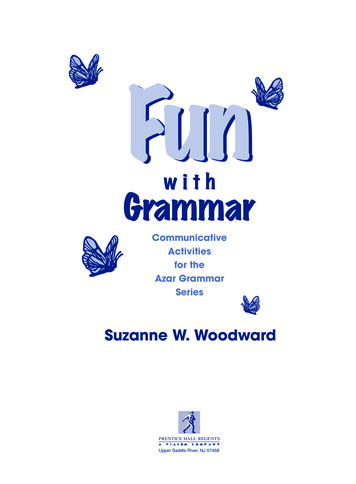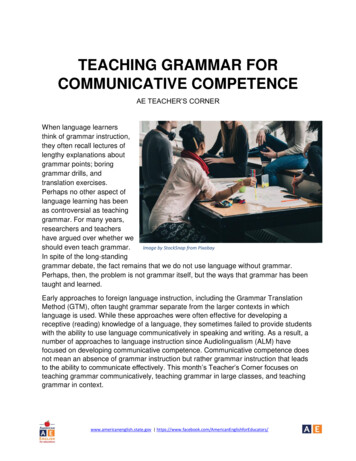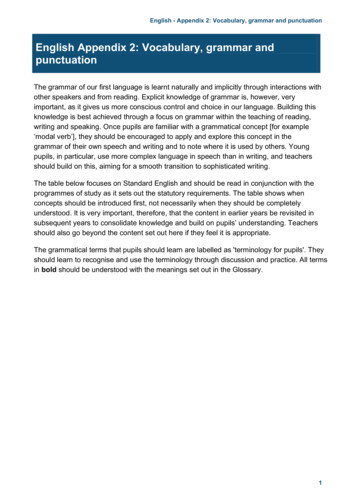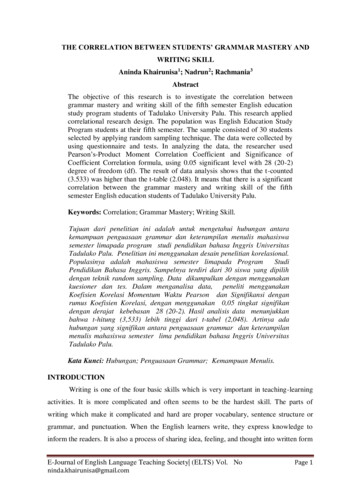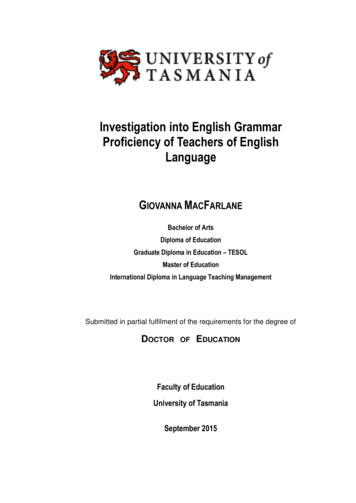
Transcription
Investigation into English GrammarProficiency of Teachers of EnglishLanguageGIOVANNA MACFARLANEBachelor of ArtsDiploma of EducationGraduate Diploma in Education – TESOLMaster of EducationInternational Diploma in Language Teaching ManagementSubmitted in partial fulfilment of the requirements for the degree ofDOCTOROFEDUCATIONFaculty of EducationUniversity of TasmaniaSeptember 2015
Declaration of originalityI, Giovanna MacFarlane, am the author of the thesis titled Investigation into Englishgrammar proficiency of teachers of English language, submitted for the degree ofDoctor of Education. I declare that the material is original, and to the best of myknowledge and belief, contains no material previously published or written byanother person, except where due acknowledgement is made in the text of thethesis, nor does the thesis contain any material that infringes copyright. The thesiscontains no material which has been accepted for a degree or diploma by theUniversity or any other institution.Giovanna MacFarlaneDate7 September, 2015i
Statement of authority of accessI, Giovanna MacFarlane, author of the thesis titled Investigation into Englishgrammar proficiency of teachers of English language, submitted for the degree ofDoctor of Education, agree that this thesis may be made available for loan andlimited copying and communication in accordance with the Copyright Act 1968.Giovanna MacFarlaneDate7 September, 2015ii
Statement of ethical conductThe research associated with this thesis abides by the international and Australiancodes on human and animal experimentation, as approved by the Human ResearchEthics Committee (Tasmania) Network –Social Sciences, Ethics Reference No.H0012170Giovanna MacFarlaneDate7 September, 2015iii
AbstractThere have been many studies that have supported the teaching of grammar andmany that have not, mainly because grammar teaching did not seem to have amarked improvement on students’ writing. In English speaking countries, traditionalgrammar ceased to be taught in the late 1960s after the Dartmouth Conference of1966, which proved to be a catalyst for change in government policy in thosecountries. As a consequence, grammar has been taught in a progressivelyattenuated manner since that time. Australia has now inaugurated a nationalcurriculum requiring teachers to teach grammar. The question is whether, afteralmost 50 years of this situation, teachers are equipped to fulfil this requirement. Asthis policy has been instrumental in the preparation of teachers in differenteducational sectors (in domestic school settings and in international Englishteaching settings), this study was conducted with a group of teachers in an Englishlanguage teaching centre attached to an Australian university, providing tuition forinternational students intending to pursue tertiary studies through the medium ofEnglish language.The aim of this study was to discover whether teachers of English at the languageteaching centre experience difficulties in their own understanding of Englishtraditional grammar, and, if so, which aspects of grammar cause them particulardifficulty. Those grammar items identified as problematic would be included in aprofessional development program specifically devised for teachers at that centre.Teachers’ views on the importance of grammar were also canvassed. The study wasconducted as an action research project, employing a mixed method approach withcollection of both quantitative and qualitative data. The study was carried out inthree distinct phases. This study was a sequential one, with each phase analysedbefore the next phase began, and with each phase informing the subsequent one.Instruments used in the three phases were (i) inventories; (ii) surveys; and (iii) semistructured interviews.iv
The study had five major findings, the first and most important of which was thatmany of the respondents showed a lack of understanding of certain aspects ofgrammar. There was also some evidence regarding lack of confidence in this area.Teaching grammar in context was the most preferred method among therespondents. The findings fulfilled the study objectives which included gainingteacher views on the significance and importance of grammar knowledge in TESOLteaching; discovering any gaps in the respondents’ grammar knowledge; anddevising a professional development program in grammar specifically tailored totheir needs.Some of the implications resulting from this study are that:(i) universities should take a more visible and concerted lead in teaching grammarto student teachers to better prepare them for (a) teaching grammar in domesticschools to fulfil the aspirations of the new Australian Curriculum; and (b) teachinggrammar to international students, who expect their teachers to impart soundgrammar knowledge to them;(ii) all teaching institutions (both schools for domestic students and English teachingcentres for international students at tertiary level) should provide professionaldevelopment in grammar for current teachers.v
AcknowledgementsThanks are due to my supervisors over the period of my candidature, namely DrThao Lê, Dr Si Fan and Dr Paul Throssell for their kind help and advice to me – anovice in the research field.I would also like to express my gratitude to the respondents in this study – a mostdedicated band of English teachers.Ms Diana Giblin and Dr Hoang Nguyen very kindly proofread the manuscript andmade very salient suggestions.My daughter, Lucia MacFarlane, formatted the manuscript in the required manner,a task which was beyond me to do.My husband, Nick MacFarlane, and all my family encouraged me to keep going untilI reached the finishing line.This thesis is dedicated to the memory ofGiuseppe and Nicolina Pignalosa, my parents,who always encouraged me to get an education,and who brought me to this country when I was a young child,where it was a case of “sink or swim” in the unfamiliar milieuof the English language.Deo Gratiasvi
Table of Contents123Introduction . 11.1Theoretical background . 21.2Contextual background . 41.3Significance of the study. 61.4Research aim and objectives . 81.5Originality of this study . 121.6Ethical issues . 131.7Structure of thesis . 141.8Conclusion . 16Literature Review . 182.1Grammar: definitions and theories . 192.2The demise of grammar teaching. 232.3The resurgence of interest in grammar. 292.4Grammar teaching controversies . 302.5The role of grammar in second language learning and teaching(TESOL). 392.6Teacher development in the teaching of English grammar . 452.7Teacher development in TESOL grammar teaching . 492.8Grammar in the Australian Curriculum . 582.9Relationship between the literature review and this study. 642.10Conclusion . 66Methodology . 683.1Research paradigms and methodologies . 683.2Mixed method approach to research . 713.3Action research . 733.4Research aim, question and objectives . 803.5Site, participants and sampling for this study . 813.6Research design and instrumentation used in this study . 84vii
4563.7Data collection . 923.8Data analysis . 943.9Validity and reliability of this study . 1003.10Triangulation. 1013.11Conclusion . 102Data Analysis and Results .1044.1Different aspects of data analysis and results. 1044.2Data categories collected – qualitative and quantitative . 1054.3Data Analysis . 1084.4Relevance of analysis to research aim, question and objectives . 1234.5Conclusion . 139Discussion .1415.1Research Objective 1 . 1415.2Research Objective 2 . 1465.3Research Objective 3 . 1515.4Research Objective 4 . 1645.5Research Objective 5 . 1695.6Research Objective 6 . 1725.7Conclusion . 173Conclusion .1756.1Summary of research findings . 1756.2Significance of the research . 1806.3Author’s reflections . 1816.4Research strengths . 1836.5Research limitations . 1846.6Educational recommendations . 1856.6.16.6.26.6.36.6.4Recommendation for government . 185Recommendations for educational policy makers. 185Recommendations for curriculum designers . 187Recommendations for teachers . 1886.7Possible future research directions . 1896.8Conclusion . 190References .193viii
Appendix 1Phase 1: Grammar Inventories - problems experienced.206Appendix 2Phase 1: Grammar Inventories - teacher requests .211Appendix 3 Phase 1: Grammar Inventories – analysis of problemsexperienced.213Appendix 4 Phase 1: Grammar Inventories - analysis of problems plusrequests .214Appendix 5Phase 2: Survey – qualitative questions (Section A) .216Appendix 6Phase 2: Survey - grammar reviewAppendix 7Phase 2: Survey – Section A - aggregate answers.221Appendix 8Phase 2: Survey – Section B - aggregate answers .238Appendix 9Phase 3: Interview transcripts.241(Section B) .217Appendix 10Phase 2: Survey - respondents’ scores (Section B) .254Appendix 11Professional Development in Grammar - Session 1 .256Appendix 12PD Session 1: Participant Evaluation Forms .274Appendix 13Research Authorisation Documents.286ix
List of Tables and FiguresTable 2.1 Advantages and disadvantages of various grammar teachingmethods in TESOL . 39Table 2.2 Year level grammar items from the Australian Curriculum . 60Figure 3.1: Seven stages of action research . 79Table 3.1 Research Objectives (R.O.) for this study . 80Figure 3.2 Relationship between the 3 phases of the research project andthe resultant PD program . 85Table 3.2 Contribution of each instrument to the Research Objectives (R.O.) . 91Table 3.3 Issues arising from Phase 2 (Section A) and how they were linkedto Interview Questions in Phase 3 . 97Table 3.4 Category & coding system for grammar items identified as difficultfrom inventories and from grammar review . 99Table 4.1 Issues emerging from inventories, subsequently included ingrammar review .119Table 4.2 Phase 2, Section B, Grammar Review: number of itemscontributing to the marking scheme .121Table 4.3 Number of years teaching English and scores on grammar review .133x
1IntroductionThe English language can be considered the modern lingua franca, that is, it iswidely used as a means of communication between people whose first languagesare diverse. From the Middle Ages until recent history, Latin was used as the linguafranca (Powney, 2013); however, its place has now been taken by English, which is,at this time, commonly used in international communication between businesspersons from different language backgrounds, for whom English is a second or thirdlanguage. Moreover, towards the beginning of the 21st century it was estimatedthat non-native speakers of English outnumbered native speakers by 2:1(Rajagopalan, 2004) or even by 3:1 (Crystal, 2003). The Internet-based Ethnologue(2013) has given a later estimation of 4:1). This has implications for the teaching ofEnglish as the market continues to grow for effective English language teaching tointernational students, and for imparting effective knowledge about language todomestic students.Historically, grammar and language structure were important parts of training in thestudy of English language. In recent decades, however, English grammar teachinghas been given progressively less emphasis in English speaking countries (Hudson &Walmsley, 2005), as more emphasis has been placed on spontaneity and creativity,rather than on correctness of form. There now appears to be a realisation thatgrammar needs to be imparted even to native English speakers for the purposes ofclear communication. Thornbury (1999) explains that, historically, no other issuehas attracted the attention of researchers and teachers as much as the grammardebate. Moreover, he goes on to assert that the history of language teaching isreally “the history of the claims and counterclaims for and against the teaching ofgrammar” (p. 14).The inherent problem in the imparting of knowledge about grammar is thatteachers have been increasingly poorly prepared for this task over the last 50 years(Hudson & Walmsley, 2005). As teachers have not been well prepared for the1
teaching of grammar in their teacher education courses for such a long period oftime (Mueller & Grant, 2011), the concept of grammar teaching has now become achallenge in Australia. This is all the more so since the new Australian Curriculum(Australian Curriculum, Assessment and Reporting Authority [ACARA], 2012b)requires all school teachers to be responsible for the teaching of grammar, and alsosince international students expect their English teachers to be knowledgeableabout grammar in order to effectively teach it in their English courses.This introductory chapter consists of sections on both the theoretical and thecontextual backgrounds to the stated problem of lack of grammar knowledge onthe part of teachers of English language. This is followed by a section on thesignificance of this study. The research aim and objectives are given next, followedby originality of the study. It will then move to ethical issues and structure of thethesis. A concluding section then brings this chapter to a close.1.1Theoretical backgroundThere are two aspects to the background of this research. One concerns teachers ingeneral and the other concerns specialist teachers of English. In January 2008, theAustralian Federal Government announced the introduction of a nationalcurriculum (Gillard & Rudd, 2008). By February 2010, the federal Minister forEducation at that time, Julia Gillard, was reported as saying “For the first time,grammar will be set out explicitly at every year level” (Rodgers, 2010). In the Englishstrand of the new Australian Curriculum (ACARA 2012b), the teaching of grammar isto be included at all levels in both primary and secondary schooling; furthermore,all teachers will be responsible for this task, not only teachers of English. This couldpresent a problem – the question needs to be asked as to whether current teachersin schools understand grammar concepts, be they teachers of English or teachers ofother subjects, or indeed specialist teachers of English language to internationalstudents. Further to that question, another of even greater significance is whethercurrent teachers have themselves been taught grammar. The new AustralianCurriculum makes it clear that literacy knowledge and skills are developedprogressively and are essential for student success in all learning areas. Therefore,2
the imparting of literacy knowledge for the development of literacy skills isconsidered to be the responsibility of all teachers (ACARA, 2010). Grant and Mueller(2010) argue that there is a large gap between the training that current teachershave received and what they are now being asked to teach. In view of this, teachersmay be able to instinctively model good English usage, but it might be difficult forthem to offer advice and guidance on students’ use of English and give reasons forsuch advice.Specialist English language teachers, such as those employed in university Englishlanguage teaching centres, are also largely products of the system which has notadequately prepared teachers to teach grammar. By their own admission, teachersfeel that there are gaps in their knowledge, and they would like to be moreadequately prepared to answer students’ probing grammar questions. To this end,this study sought to identify what exactly these gaps are. This would then lead to aprofessional development program to help teachers to become moreknowledgeable and confident about their ability both to teach grammar and toanswer student questions about grammar.The question of whether to teach grammar or not to teach it is a vexed one. Thetitle of a recent publication, My Grammar and I, or should that be ‘Me’? (Taggart &Wines, 2008), albeit tongue-in-cheek, serves to point out that grammar, includingits place in clear communication, is poorly understood. Careless grammar can leadto misunderstandings in both oral and written English. Moreover, if students do notmanage to internalise a certain amount of grammar, they will not understand somelanguage structures (Northumbria University, 2010), which will then lead to abreakdown in understanding and communication even though they might be nativeEnglish speakers. In some countries, for example Germany, students are taughtgrammar – German grammar. In that particular context, Germans do not just relyon grammar intuition that children develop in the first few years of life. As studentsgrow into adulthood and deal with more complex issues, their knowledge ofgrammar, which has been actively taught to them, can subconsciously facilitate thatcommunication.3
Australia is a multi-cultural country where immigrants from many language groupsare accepted. As well as adult international students, immigrants are yet anotheradult group who need to be taught English. The inclusion of effective grammarteaching would be very powerful for them, as grammar learning provides adultswith a way of grouping grammatical information together, thus obviating the needto learn each utterance separately. Adults do not learn a second language in thesame way that infants learn their mother tongue.An educational weakness in Australia is that few people study a second language. LoBianco (2009) points out that despite government policy in this area, secondlanguage learning translates to “low school completion rates, high rates of attritionfrom university language programs and a decline in the number of languagestaught, their duration, spread and level of seriousness” (p. 1). Lo Bianco recognisesthat Australia shares this situation with other English speaking nations, and gives asa possible reason “the perceived global domination of English” (p. 9). For thisreason, students appear to think that learning other languages is unimportant. Thefew Australian students who do engage in serious study of a second language,including grammar, then have the benefit of understanding grammar structures intheir first language – English. It is doubtful whether intuition alone is adequate evenfor monolingual people, and even more doubtful for those acquiring a second orfurther language.1.2Contextual backgroundGrammar cannot be considered as a static concept. Traditional grammar is grammarthat has been inherited from studies of Latin and Latin-based European languages.Grammar can change and be modified. In the context of this study, grammar isdefined as a modified version of traditional grammar. By way of clarifying this pointregarding modification, all modern English grammar books refer to conditionals aszero, first, second and third conditionals. In traditional grammar, the onlyconditional is that which is now known in English grammar as the first conditional,as this is the only one that has a true condition inherent in the meaning, e.g. If itrains tomorrow, I will stay at home. The main clause I will stay at home is contingent4
on the condition if it rains tomorrow. The zero conditional is not a true conditional(as implied by its name), e.g. If water reaches 100 degrees, it boils. The if can bereplaced by when or whenever and is a statement that is always true, so there is nota real condition within the meaning. The second and third conditionals are knownas present and past subjunctives in traditional grammar. These types of sentencesdo not display conditions as such, but rather introduce elements of doubt, desire,regret or even advice-giving. The following examples show these structures. (1) If Iwere you, I would study hard (second conditional / present subjunctive). There is nocondition here; it is a piece of advice. (2) If I had studied harder when I was a child, Iwould/could/ might have become a doctor (third conditional / past subjunctive).There is no condition here either; it is a regret about a past situation that cannotpossibly be changed because it is too late. Therefore, the second and thirdconditionals (present and past subjunctives in traditional grammar) relate to unrealsituations, not conditions as such. This is one example of a difference betweencommon modern English grammar understanding and traditional grammarunderstanding.Recent research reported in Science Daily (Northumbria University, 2010) showedthat there are questions about Chomsky’s theory of universal grammar, whichclaims that all native speakers of a particular language have the grammar hardwired into them because they speak that language (Munoz, 2011). The research wascarried out by academics at Northumbria University (2010), who pointed out that,according to Chomsky, grammar is gained through intuition from infancy. Incontrast to Chomsky, their thesis encompassed the idea that a significant number ofnative English speakers are unable to understand some basic sentences – thepublished report concentrated particularly on the passive voice in English grammar.This Northumbrian project assumed that every adult native speaker of Englishwould be able to understand the sentence “The soldier was hit by the sailor.” Therespondents were adults and it was found that a high proportion of those adultswho had left school at 16 were unable to identify whether the soldier or the sailorwas the doer of the action in that sentence. This type of lack of understandingdeserves some attention to be given to it by educators.5
Equally significant is the impending disappearance of the English adverb, especiallythe comparative adverb. This demise has been noted and commented on by writersin disciplines as disparate as medicine (Henry, 2009) and management (Fagiano,1992). It is not a question that concerns language teachers only. Henry (2009) writesregarding presentations given by medical personnel at medical conferences andcomments on the standard of grammar, including specifically the failure to useadverbs. Fagiano (1992) writes about the disappearing adverb and how this impactson marketing and management. Freeman (2006) writes on this topic from ajournalistic point of view, and cites the very public example of the Apple computercompany’s slogan “Think Different” (rather than “Think Differently”). This is anexample of marketers using language in a way that is unusual in order to attractattention. Although this particular example does not cause confusion as such, it ispossible for confusion to be created, and this point will be further explored in theLiterature Review chapter of this thesis as many more examples of the demise ofthe adverb can readily be found in the media.1.3Significance of the studyResearch literature shows that teachers do indeed lack grammar knowledgebecause for the last 50 years grammar has not been given very much attention.There is ample evidence of this fact in Andrews (1999; 2007); Harper and Rennie(2009); Hudson and Walmsley (2005); Kömür (2010); Louden et al. (2005); Loudenand Rohl (2006); and Rohl and Greaves (2005), as illustrated in the LiteratureReview chapter of this thesis. Therefore, current teachers are likely to be unsure oftheir own level of understanding in relation to grammar. However, during thecourse of the review of the extant literature for the purposes of this thesis, nostudies were found which led to the writing of a professional development programthat specifically addressed the gaps in the respondents’ grammar knowledge. It maybe time to redress this problem and to give teachers of English language whateverhelp is required in order to allow them to fulfil their mission. The advantages of thisstudy are that the teacher respondents will have the opportunity to improve andextend their knowledge of grammar through the professional development6
program that will be devised and tailored specifically to their needs. This enquirycould be useful for other tertiary English teaching centres, as any other such centrecould conduct this type of research to discover the grammar needs of theirparticular teachers and then implement a program to help them improve theirknowledge of grammar.The review of relevant literature for this research showed that studies which havealready been conducted into teachers’ grammar knowledge are based mostly onwhat teachers say they know or do not know about grammar in general. Only twostudies were found which attempted to discover actual lack of knowledge ofspecific grammar items. These were Kömür (2010) and Andrews (1999) (refer toLiterature Review chapter of this thesis). In the case of Kömür (2010), the study wasconducted with non-native English speaker student teachers in Turkey and did notreport on any list of grammar items, but rather on the respondents’ intendedstrategies to overcome their ind
traditional grammar, and, if so, which aspects of grammar cause them particular difficulty. Those grammar items identified as problematic would be included in a professional development program specifically devised for teachers at that centre. Teachers views on the importance of



